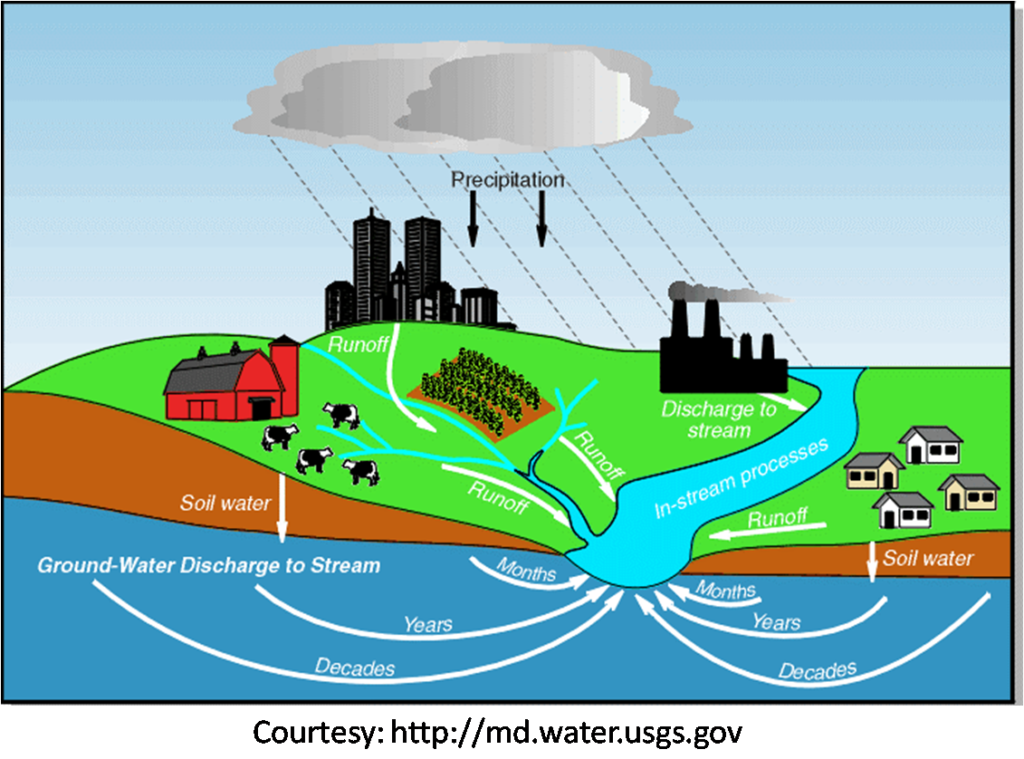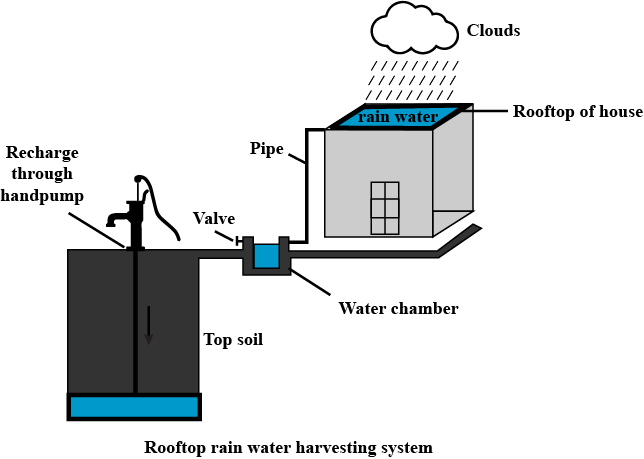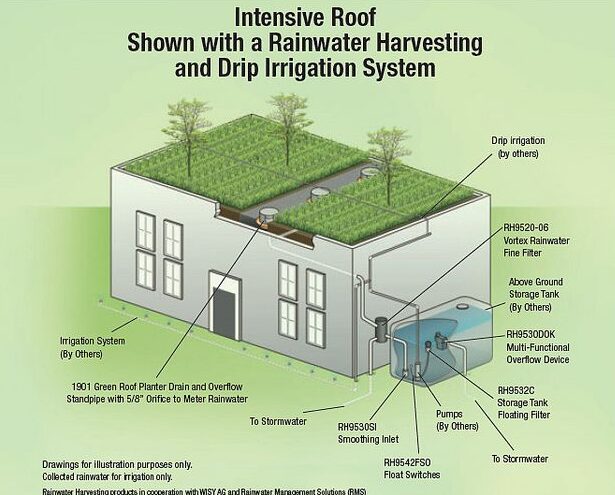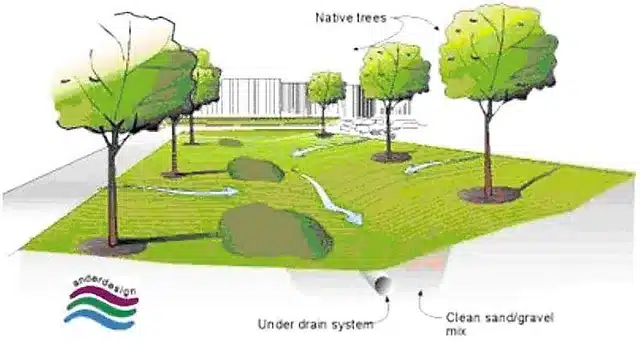Rainwater harvesting is a smart way to save money and conserve water resources. Installing a rainwater harvesting system is generally easier, and examples from around the world for 7 types of rainwater harvesting systems are explained in detail. This article will explore seven amazing ways to harvest rainwater and use it for various purposes such as gardening, irrigation, and more.
1. Surface Runoff Harvesting
Surface runoff harvesting is the process of capturing rainwater that flows over land and surfaces during rainfall events.
This type of harvesting is particularly useful in urban areas where large quantities of rainwater run off impervious surfaces like roads, buildings, and pavements.

Here are some more details on the process:
- Surface runoff harvesting typically involves constructing channels or catchment areas to capture the runoff and direct it to storage tanks or recharge pits.
- The catchment areas can be constructed using a variety of materials, such as concrete, bricks, or natural materials like rocks and pebbles.
- The collected water can be treated and used for non-potable purposes, such as watering plants, flushing toilets, and cleaning.
Benefits of Surface Runoff Harvesting:
- Surface runoff harvesting helps in conserving water resources and reducing dependence on groundwater sources.
- It helps in reducing the amount of stormwater runoff that flows into the drainage systems, thereby reducing the risk of flooding and erosion.
- By reusing rainwater for non-potable purposes, surface runoff harvesting helps in reducing the demand for treated drinking water, which is a precious resource.
How Surface Runoff Harvesting Impacts You:
- Harvesting rainwater can create a sense of self-sufficiency and empowerment as users take control of their water supply and reduce their reliance on external sources.
- It can also create a sense of environmental responsibility and contribute to a more sustainable lifestyle.
Real-life examples of Surface Runoff Harvesting:
- The city of Melbourne, Australia, has implemented a large-scale surface runoff harvesting system that collects and treats rainwater from streets and public spaces for non-potable uses.
- In Bangalore, India, a community-led initiative called “Rainwater Club” has implemented surface runoff harvesting techniques to capture and store rainwater for domestic and agricultural use.
- In California, the city of Los Angeles has implemented a program that provides financial incentives to property owners who install surface runoff harvesting systems, with the aim of increasing local water supplies and reducing demand on imported water.
In summary, surface runoff harvesting is a valuable technique for capturing and utilizing rainwater runoff in urban areas.
2. Rooftop Rainwater Harvesting
Rooftop rainwater harvesting is the process of capturing rainwater that falls on the roof of a building and storing it for later use. This type of harvesting is particularly useful in areas where there is limited access to water resources or where the quality of groundwater is poor.

Here are some more details on the process:
- Rooftop rainwater harvesting typically involves installing gutters and downspouts on the roof to collect rainwater and direct it to storage tanks or recharge pits.
- The collected water can be treated and used for non-potable purposes, such as gardening, irrigation, and flushing toilets.
- The rooftop rainwater harvesting system can be designed to either store the water in a tank for later use, or to recharge the groundwater table directly by percolating the water into the soil.
Benefits of Rooftop Rainwater Harvesting:
- Rooftop rainwater harvesting helps in reducing the demand for municipal water supplies, thereby reducing the burden on water treatment plants and lowering the energy costs associated with water distribution.
- It helps in conserving water resources and reducing dependence on groundwater sources.
- By reusing rainwater for non-potable purposes, rooftop rainwater harvesting can save users money on their water bills.
How Rooftop Rainwater Harvesting Impacts You:
- Harvesting rainwater can create a sense of self-sufficiency and empowerment, as users take control of their water supply and reduce their reliance on external sources.
- It can also create a sense of environmental responsibility and contribute to a more sustainable lifestyle.
Real-life examples of Rooftop Rainwater Harvesting:
- In Singapore, rooftop rainwater harvesting is mandatory for all new developments, and incentives are provided for retrofitting existing buildings with rainwater harvesting systems.
- In Mexico City, a housing complex called “Ciudad Verde” has implemented rooftop rainwater harvesting systems to capture and store rainwater for use in gardens and green spaces.
- In the United States, the city of Portland, Oregon, has implemented a program that provides financial incentives to property owners who install rooftop rainwater harvesting systems, with the aim of reducing the demand for municipal water supplies.
In summary, rooftop rainwater harvesting is a valuable technique for capturing and utilizing rainwater in areas where there is limited access to water resources.
It can provide numerous benefits for both individuals and communities, while also promoting a more sustainable lifestyle and a greater sense of environmental responsibility.
3. Infiltration Trenches
Infiltration trenches are shallow ditches or trenches that are filled with porous materials, such as stones or gravel, and used to capture and infiltrate rainwater into the ground.

Here are some more details on the process:
- Infiltration trenches typically involve digging a shallow trench in the ground, filling it with a layer of porous materials, and covering it with a layer of topsoil.
- The collected water can be treated and used for non-potable purposes, such as gardening, irrigation, and flushing toilets.
- The system can be designed to either capture the water from a larger catchment area or from individual downspouts.
Benefits of Infiltration Trenches:
- Infiltration trenches help in reducing the amount of stormwater runoff that flows into the drainage systems, thereby reducing the risk of flooding and erosion.
- They help in recharging the groundwater table by allowing the water to infiltrate into the soil, thereby increasing the availability of water resources.
- They are a cost-effective and low-maintenance option for rainwater harvesting.
Emotional Impact of Infiltration Trenches:
- Harvesting rainwater through infiltration trenches can create a sense of environmental responsibility, as users take control of their water supply and reduce their impact on the environment.
- It can also contribute to a more sustainable lifestyle and a greater sense of connection to the natural world.
Real-life examples of Infiltration Trenches:
- In Seattle, Washington, the city has implemented a program that provides incentives for property owners who install infiltration trenches on their properties, with the aim of reducing the amount of stormwater runoff that flows into the city’s drainage systems.
- In Delhi, India, a community-led initiative called “Jalodhara” has implemented infiltration trenches to capture and infiltrate rainwater into the ground, thereby reducing the demand for municipal water supplies.
- In Denmark, infiltration trenches are a common feature in sustainable housing developments, where they capture and infiltrate rainwater into the ground and create green spaces and urban gardens.
In summary, infiltration trenches are a valuable technique for capturing and infiltrating rainwater into the ground.
4. Permeable Pavement Rainwater Harvesting
Permeable pavement is a type of pavement that allows rainwater to seep through it and into the ground below. This type of harvesting is particularly useful in areas with heavy rainfall, where the water can quickly overwhelm the drainage systems.

Here are some more details on the process:
- Permeable pavement can be made from a variety of materials, such as concrete, asphalt, or interlocking pavers.
- The pavement typically includes porous materials or voids that allow the water to infiltrate into the ground.
- The system can be designed to either capture the water from a larger catchment area, or from individual downspouts.
Benefits of Permeable Pavement:
- Permeable pavement helps in reducing the amount of stormwater runoff that flows into the drainage systems, thereby reducing the risk of flooding and erosion.
- It helps in recharging the groundwater table by allowing the water to infiltrate into the soil, thereby increasing the availability of water resources.
- It can also help in reducing the heat island effect in urban areas by allowing the ground to absorb and release the heat.
How Permeable Pavement Harvesting Impacts You:
- Harvesting rainwater through permeable pavement can create a sense of environmental responsibility, as users take control of their water supply and reduce their impact on the environment.
- It can also contribute to a more sustainable lifestyle and a greater connection to the natural world.
Real-life examples of Permeable Pavement:
- In Portland, Oregon, the city has implemented a program that provides incentives for property owners who install permeable pavement on their properties, with the aim of reducing the amount of stormwater runoff that flows into the city’s drainage systems.
- In Chicago, Illinois, the city has implemented a large-scale permeable pavement system in the parking lots at O’Hare International Airport, with the aim of reducing the amount of stormwater runoff that flows into the nearby rivers.
- In Philadelphia, Pennsylvania, the city has implemented a “Green Streets” program that uses permeable pavement and other green infrastructure techniques to capture and infiltrate rainwater into the ground.
In summary, permeable pavement is a valuable technique for capturing and infiltrating rainwater into the ground.
5. Rain Barrels Harvesting
Rain barrels are containers that are placed under downspouts to capture rainwater. This type of harvesting is particularly useful in areas where there is limited access to water resources or where municipal water supplies are expensive.

Here are some more details on the process:
- Rain barrels can be made from a variety of materials, such as plastic, metal, or wood.
- The collected water can be used for non-potable purposes, such as watering plants, washing cars, or flushing toilets.
- The system can be designed to either capture the water from a larger catchment area, or from individual downspouts.
Benefits of Rain Barrels:
- Rain barrels help conserve water resources and reduce dependence on municipal water supplies.
- They can save users money on their water bills, particularly in areas where water is expensive.
- They can also help reduce the demand for municipal water treatment plants, thereby reducing the energy costs associated with water distribution.
Real-life examples of Rain Barrels:
- In Toronto, Canada, the city has implemented a program that provides subsidies to homeowners who install rain barrels on their properties, with the aim of reducing the demand on municipal water supplies.
- In Washington, D.C., the city has implemented a large-scale rain barrel program to capture and store rainwater for non-potable uses, such as irrigation and cleaning.
- In Los Angeles, California, a community-led initiative called “LA Rain Barrels” has distributed thousands of rain barrels to homeowners throughout the city, with the aim of reducing the demand on municipal water supplies.
In summary, rain barrels are a simple and effective way to capture and utilize rainwater.
6. Green Roofs Rainwater Harvesting
Green roofs, also known as living roofs, are roofs that are covered with vegetation and soil. This type of harvesting is particularly useful in urban areas where there is limited space for traditional rainwater harvesting techniques.

Here are some more details on the process:
- Green roofs typically involve installing a layer of waterproofing material on the roof, followed by a layer of soil and vegetation.
- The vegetation can be selected based on the local climate and the intended use of the roof, such as growing food or creating a green space.
- The system can be designed to capture and utilize rainwater for irrigation purposes, or to reduce the amount of stormwater runoff that flows into the drainage systems.
Benefits of Green Roofs:
- Green roofs help in reducing the amount of stormwater runoff that flows into the drainage systems, thereby reducing the risk of flooding and erosion.
- They help in reducing the heat island effect in urban areas by providing a cooling effect on the building and the surrounding environment.
- They can also provide habitat for wildlife and contribute to biodiversity in urban areas.
Real-life examples of Green Roofs:
- In Copenhagen, Denmark, the city has implemented a large-scale green roof program to combat the heat island effect and reduce the amount of stormwater runoff that flows into the city’s drainage systems.
- In Chicago, Illinois, the city has implemented a program that provides incentives for property owners who install green roofs on their buildings, with the aim of reducing the demand on municipal water supplies and reducing the urban heat island effect.
- In Toronto, Canada, a community-led initiative called “Green Roofs for Healthy Cities” has implemented green roofs on buildings throughout the city, with the aim of reducing the amount of stormwater runoff and improving air quality.
In summary, green roofs are a valuable technique for capturing and utilizing rainwater in urban areas.
7. Swales Rainwater Harvesting
Swales are shallow, vegetated channels that are designed to capture and slow down stormwater runoff. This type of harvesting is particularly useful in areas with heavy rainfall, where the water can quickly overwhelm the drainage systems.

Here are some more details on the process:
- Swales typically involve digging a shallow trench in the ground, and planting vegetation or laying mulch to slow down the flow of water.
- The system can be designed to either capture the water from a larger catchment area, or from individual downspouts.
- Swales can be designed to allow the water to infiltrate into the soil or to direct it to a rain garden or other type of storage system.
Benefits of Swales:
- Swales help in reducing the amount of stormwater runoff that flows into the drainage systems, thereby reducing the risk of flooding and erosion.
- They help in recharging the groundwater table by allowing the water to infiltrate into the soil, thereby increasing the availability of water resources.
- They can also provide habitat for wildlife and contribute to biodiversity in urban areas.
Real-life examples of Swales:
- In Portland, Oregon, the city has implemented a program that provides incentives for property owners who install swales on their properties, with the aim of reducing the amount of stormwater runoff that flows into the city’s drainage systems.
- In Seattle, Washington, the city has implemented a large-scale swale program to capture and slow down stormwater runoff, and to reduce the risk of flooding and erosion in urban areas.
- In Austin, Texas, a community-led initiative called “Sustainable Neighborhoods” has implemented swales throughout the city, with the aim of reducing the amount of stormwater runoff and improving the health of the local ecosystems.
In summary, swales are a valuable technique for capturing and utilizing rainwater in areas with heavy rainfall.
What are the 10 Rainwater Harvesting Advantages?
Here are 10 advantages of rainwater harvesting systems:
- Cost savings: Using rainwater for non-potable purposes can significantly reduce water bills, especially in areas with expensive municipal water supplies.
- Environmental benefits: By reducing the demand on municipal water supplies, rainwater harvesting can help to conserve water resources and reduce the energy required for water treatment and distribution.
- Improved water quality: Rainwater is naturally soft and free from minerals and chemicals, making it ideal for certain uses such as watering plants.
- Reduced flooding and erosion: By capturing rainwater and reducing stormwater runoff, rainwater harvesting can help to reduce the risk of flooding and erosion in urban areas.
- Increased groundwater recharge: By allowing rainwater to infiltrate into the soil, rainwater harvesting can help to recharge groundwater supplies and increase the availability of water resources.
- Versatility: Rainwater can be used for a wide range of non-potable purposes, including watering plants, flushing toilets, and washing clothes.
- Resilience: In areas with limited or unreliable municipal water supplies, rainwater harvesting can provide a reliable and self-sufficient source of water.
- Reduced demand on infrastructure: By reducing the demand on municipal water supplies, rainwater harvesting can help to reduce the strain on existing water infrastructure.
- Flexibility: Rainwater harvesting systems can be designed to meet the specific needs and constraints of individual properties, making them a flexible and adaptable solution.
- Educational benefits: By promoting sustainable water use practices, rainwater harvesting can help to educate individuals and communities about the importance of conserving water resources and protecting the environment.
Overall, rainwater harvesting systems can provide numerous benefits for individuals, communities, and the environment, making them a valuable solution for sustainable water management.
What are the 10 disadvantages of rainwater harvesting?
While rainwater harvesting has many benefits, there are also some potential disadvantages to consider:
- Initial installation costs can be high, depending on the system and materials used.
- Maintenance and upkeep may be required, which can be time-consuming and costly.
- There is a risk of contamination if the system is not properly maintained and cleaned.
- Water quality may be impacted by pollutants in the air or on the roof, which can affect its suitability for certain uses.
- The availability of rainwater may be limited in certain areas or during certain seasons, which can impact the reliability of the system.
- In areas with heavy rainfall, the system may become overwhelmed and unable to capture all of the water, leading to potential flooding or erosion.
- In areas with limited space, it may be difficult to install a rainwater harvesting system.
- In areas with high demand for water, rainwater harvesting may not be sufficient to meet all of the water needs.
- In some cases, the cost of implementing a rainwater harvesting system may not be financially feasible for individuals or communities.
- Rainwater harvesting may not be permitted by local regulations or building codes in some areas.
It is important to carefully consider these potential disadvantages when deciding whether or not to implement a rainwater harvesting system.




